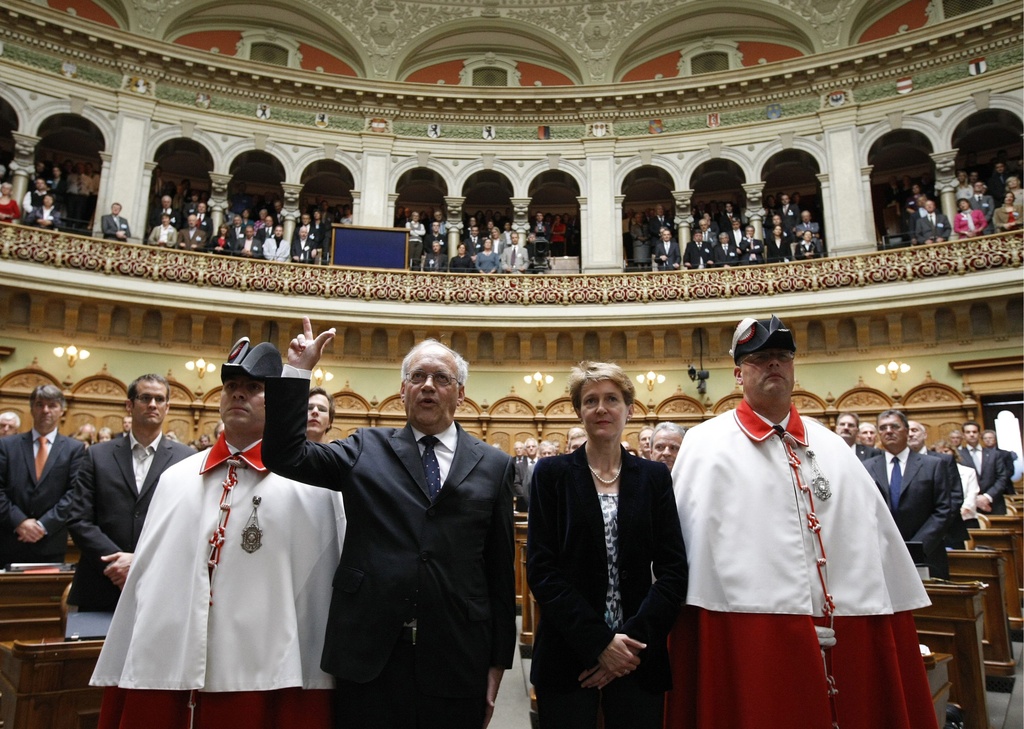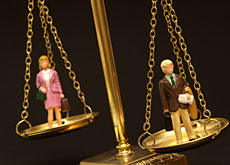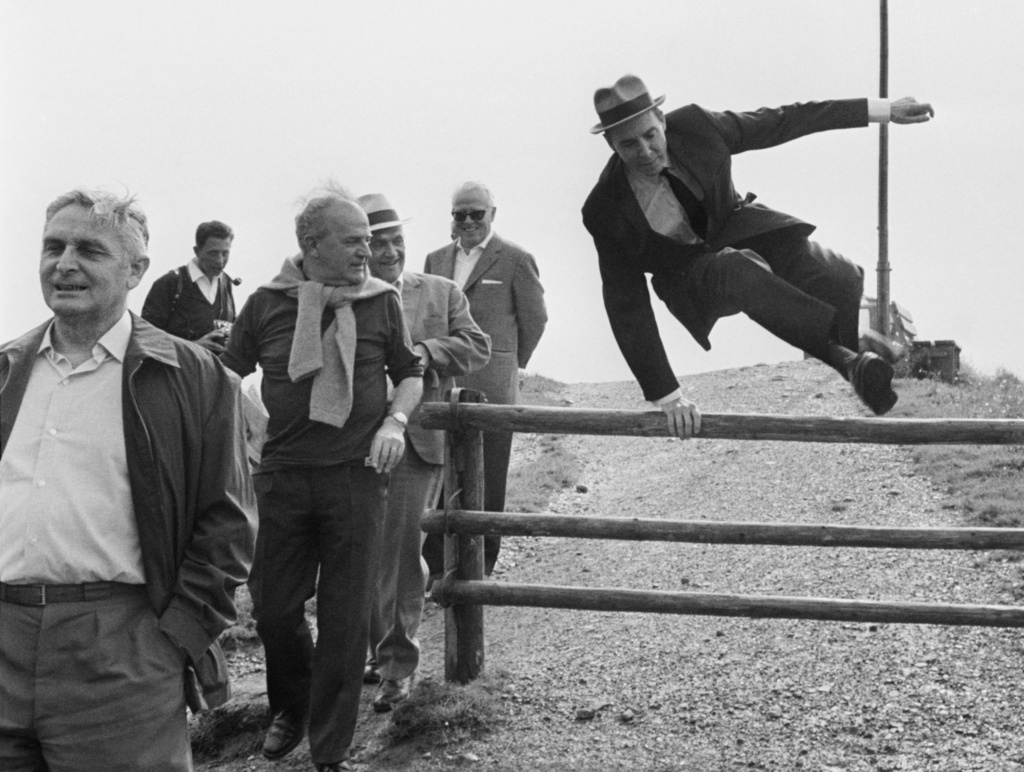Women hail feminine cabinet majority

After the “extraordinary” election of a first female majority in the Swiss cabinet, women’s rights campaigners hope it will resonate in areas where inequality remains.
Parliament’s choice on Wednesday of 50-year-old consumer advocate and Social Democrat Simonetta Sommaruga as the fourth woman in the seven-seat cabinet tipped the gender balance in women’s favour for the first time in Swiss history.
The result has been hailed as a symbolic moment for women’s rights in a country that only gave women the vote in 1971 – long after Afghanistan, Syria and Iran had done so.
Switzerland now becomes only the fifth country in the world to have a female majority in government, along with Norway, Spain, Finland and Cap Verde.
“I think it’s wonderful. When it comes to the executive, most countries drag their feet,” said Anders Johnsson, secretary-general of the Geneva-based Inter-Parliamentary Union.
Switzerland’s pioneering new status could shift as early as October 2011 when cabinet re-elections are held.
However long it lasts, the Federal Commission for Women’s Issues said the outcome was an “extraordinary event for the Swiss confederation”, considering modern-day Switzerland has not been governed by a female majority since its official creation in 1848.
“At the same time we hope that this election will have a positive effect on the equality of opportunities between men and women in the entire political system, where women are still a minority,” spokeswoman Elisabeth Keller told swissinfo.ch.
In parliament, women take up 21.7 per cent of the Senate seats and 29.5 per cent of those in the House of Representatives.
“One also hopes that this election will be a positive sign for change in Swiss politics and that it will encourage young women and men to become involved,” added Keller.
“Spectacular” gap
Elsewhere in Switzerland, the picture of equality is not all rosy. The federal commission says there are big gaps between men’s and women’s salaries, women have problems juggling work and family life, domestic violence continues to be a major issue and there is a general lack of women in top positions in politics, economics and education.
Other organisations point to poor crèche facilities, poverty levels for women, small pensions as a result of lower salaries and an overall struggle to have financial independence.
In a recent special report on women rights, the French language weekly L’Hebdo offered a glimpse into early findings of a Swiss National Research Programme study into business leaders. Researchers said there was a “spectacular” lack of women in company boards of directors or top management, due potentially to their absence from such ‘old boy’ networks as the army or the Rotary Club.
The magazine found that there were four women at the helm of the top 110 Swiss companies and there was just one woman rector among universities and federal institutes of technology. Of the 57 key posts in the government’s top-level administration, ten were held by women – this even in the three ministries headed by women.
Claudine Esseiva, a member of the Radical Party says the strong female representation currently at the upper echelons of politics – both houses of parliament are also presided over by women – is a confluence of unusual circumstances.
“You get a bit of a wrong picture if you just look at the federal government,” she said, adding that there are less women in politics in eastern Switzerland than in the west. In one canton, Appenzell Inner-Rhodes, women couldn’t vote in local elections until a Swiss Federal Tribunal ruling in 1990.
And yet Switzerland’s strong tradition of grassroots democracy, with elected officials wielding power down to the village level, has helped women rise through the political ranks ever since they were given the vote.
Encouraging
Josiane Greub, of the Swiss association for promoting women’s rights, ADF, said she was delighted with the election result, and that it was an achievement that her association had been working towards ever since its creation 101 years ago.
But she cautioned against the result possibly sending out the wrong signals.
“It is encouraging and symbolic. This decision was made to improve federal politics. It’s for the good of society, not for the good of women. They thought these women were competent to lead the country, and it recognises the value of women,” she told swissinfo.ch.
“But to say that equality has been achieved would be negative, because there is still a lot to do. The problem of equality and justice for women is far from being solved.”
With its 4-3 cabinet majority Switzerland joins just four other nations with female majorities in government: Finland, Norway, Spain and Cap Verde. Finland has the record with 12 women serving in 19 ministerial posts (63%). Norway, Spain and Cap Verde’s women’s representations are at around 53%. In two-thirds of 100 countries on an Inter-Parliamentary Union list, the percentage of women in government is around the 25% mark.
From 1983-2010 the rate of women in communal government rose from 5.8%-27%. In big towns, around a third of members of executives are women.
Bern was the first city to have more women than men in government from 1993-1996, and it has once again had a majority since 2004.
The first woman to be elected to a Swiss cantonal government was Hedi Lang in 1983. Since then women have climbed to a 22% representation rate in cantonal executives. Zurich canton had a female majority from 2003-2007.
Simonetta Sommaruga and Johann Schneider-Ammann were elected by parliamentarians to the Swiss cabinet on September 22.
Sommaruga from the centre-left Social Democratic Party replaced party colleague Transport Minister Moritz Leuenberger. Schneider-Ammann replaced centre-right Radical Party colleague Finance Minister Hans-Rudolf Merz.
Both outgoing ministers stepped down 14 months before the end of the current four-year term.
The cabinet’s political make-up thus stayed the same. The seven cabinet members have to be confirmed in their posts every four years in the wake of parliamentary elections due in October 2011.
1971: Majority of Swiss men vote to accept women’s suffrage. In the next elections, 10 women elected to House of Representatives.
1990: Canton Appenzell Inner Rhodes forced by Swiss Federal Tribunal to give women the vote.
1999: Ruth Dreifuss becomes first female Swiss president (an honorary, rotating position).
2003: First female majority in cantonal government in Zurich, with four women.
2003: Ruth Metzler-Arnold is not re-elected to the cabinet, leaving only one woman. Women protest on the street.
2008: Eveline Widmer-Schlumpf’s election means there are three women in the cabinet for the first time.
2010: For the first time women occupy the three highest political positions in Switzerland: Swiss President and the two speakers of parliament. Simonetta Sommaruga is elected, tipping the female-male balance 4-3.

In compliance with the JTI standards
More: SWI swissinfo.ch certified by the Journalism Trust Initiative















You can find an overview of ongoing debates with our journalists here . Please join us!
If you want to start a conversation about a topic raised in this article or want to report factual errors, email us at english@swissinfo.ch.